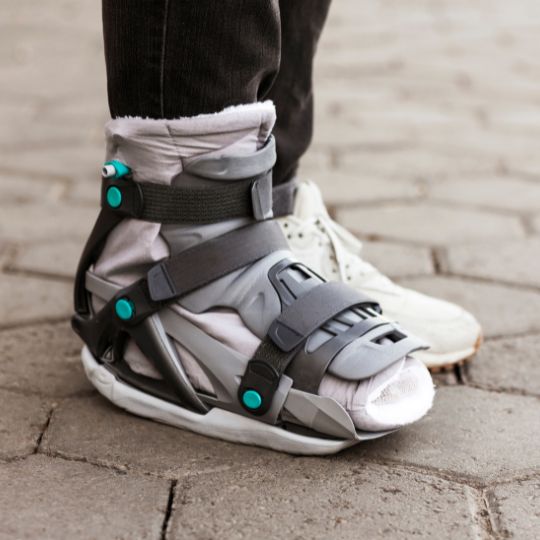Whenever I see a patient with a foot injury, we discuss whether a foot brace or boot is appropriate. In this blog post, I’m talking about hard braces, not supportive “braces” like soft wraps or compression socks. Especially when it comes to performing artists, devices such as these can be very intrusive and cause problems with training and performing. It’s safe to assume they’re necessary given how prevalent they are in treatment plans. However, is this just an example of providers being unsure of how to properly treat performing artists?
What is a foot brace good for?
To start, devices like these are great for immobilizing unstable areas. This can be very beneficial we’re talking about broken bones, torn tissue or dislocations. In each of these cases, the injured area is no longer functional and needs to be physically held in place during the healing process. Torn ligaments/tendons, a shoulder out of place and a bone that’s now in two or more pieces can no longer function in any reliable capacity. In these instances immobilizing the area is the best chance the body has at healing and returning to pre-injury status.
When shouldn’t you use a foot brace or boot?
Literally every other instance that isn’t a fracture, tear or dislocation! The point of a brace is to stop a region from moving. It’s about providing stability to an anatomically unstable area. But if we’re talking about sprains and strains, then we’re talking about weakness NOT instability. In these instances the focus should be on dialing back the stress that the area undergoes simultaneously strengthening the area. Braces prevent movement of the area, making it impossible to strengthen.
Foot Braces ALWAYS come with a cost.
Braces lock and area in place to stabilize something that is unstable. This can be helpful but it’s important to remember that the research has long since shown that immobile tissue gets worse, not better, from a functional standpoint. Because the tissue isn’t moving it becomes weaker and more susceptible to limitations in range of motion. If we’re talking about fractures, tears and dislocations that’s a price we’re going to have to pay in order to re-stabilize the area BEFORE ultimately strengthening. But if the tissue is just weakened by an injury, then the brace is actively going to make the injury worse resulting in a much longer recovery period.
In conclusion…
If it ain’t broke, DON’T brace it! If the joint or region is still functional, there is no reason to use a brace. That means no more putting boots on ankle sprains. Instead focus on RICE. RICE stands for Rehab, Ice, Compression and Elevation. Notice the C for compression. Here we’re talking about compression socks and soft wraps. That IS a good idea for weakened but functional tissue.
If you follow these general rules you’ll be able to save yourself a lot of stress and get back on the stage sooner while avoiding overly long recovery times. Of course if you’re unsure whether you should be using a brace or not, book an appointment with me HERE. With over 25 years of experience as a dancer I know all about the importance of creating an effective treatment plan that gets you back on stage as fast as possible.





